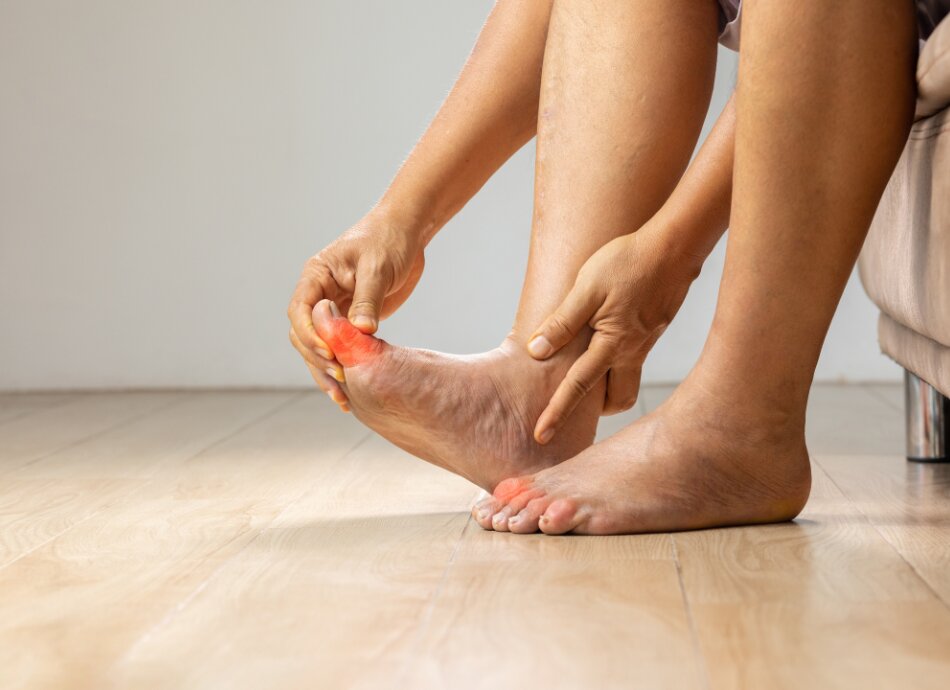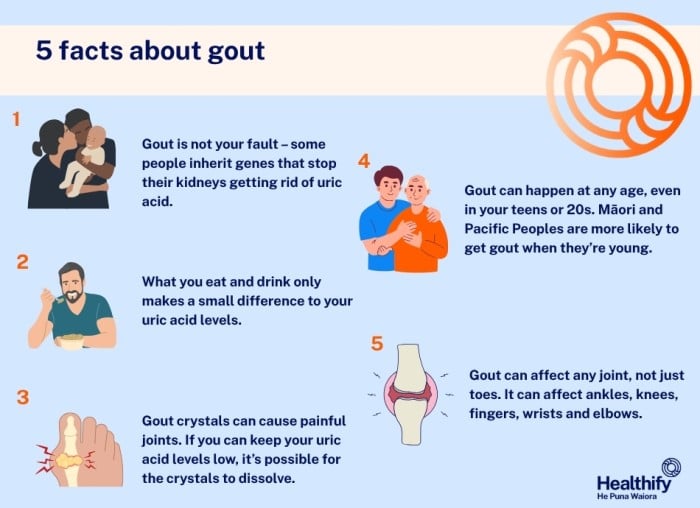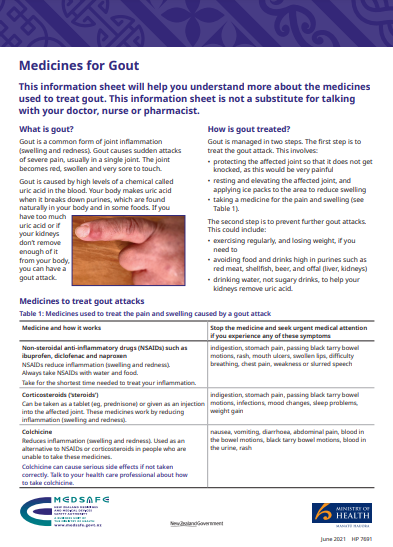Gout | Mate waikawa kai kōiwi
Key points about gout (mate waikawa kai kōiwi)
- Gout is a type of long-term inflammatory arthritis.
- It's due to a build-up of uric acid in joints and causes sudden, severe joint pain and swelling, especially in your toes and fingers.
- If you don't get treatment it can cause permanent damage to your joints and can harm your kidneys.
- See your healthcare team for treatment to help during an attack and to stop further attacks.

- Gout is the most common form of inflammatory arthritis. It's caused by a build-up of uric acid in joints which is often very painful.
- Most Māori and Pacific Peoples have genes that stop their kidneys getting rid of uric acid in their urine.
- If your kidneys can't get rid of uric acid, it turns into crystals in your joints which cause a painful gout attack. Once the pain goes away the crystals remain in the joints.
- If you don't treat your high levels of uric acid, the crystals can cause permanent damage to your joints and harm to your kidneys.
- The only way to help your body get rid of uric acid and dissolve the crystals in your joints is to take long-term uric acid medicines.
- Gout is not your fault. There is no shame in having gout, and no need to blame yourself. Remember it's your genes that stop your kidneys getting rid of uric acid.
Video: What is gout?
This video may take a few moments to load.
Video: Gout is not your fault
This video may take a few moments to load.
Closed captions in English, Samoan and Tongan are available and can be turned on using the subtitles icon to the bottom right of the YouTube screen. Closed captions in Cook Island Māori are available here(external link).
Gout is a long-term condition and the most common form of inflammatory arthritis. If you don’t get the long-term uric acid medicine you need to reduce your levels of uric acid, you will keep on having gout attacks (flares).
Gout attacks (flares) are painful and stressful. They can affect your mental health, wellbeing and relationships. You may find it difficult to spend time with your whānau and friends as well as attend social events. Working can be difficult and this can affect your income. With treatment, your levels of uric acid can be reduced, and you’ll no longer suffer from those painful gout attacks. You’ll be able to be more active, have less pain and do the things you weren’t able to before.
Read about living well with gout in the tab below.

Image credit: Healthify He Puna Waiora, NZ
- A gout attack usually begins suddenly, often at night. Within hours, the joint can become red, swollen, hot and very painful. People with gout often describe the pain as the worst pain they have ever felt.
- The joint most commonly affected is the big toe. Gout can also affect other joints in your foot, your knee and your fingers, wrists and elbows.
- The pain and tenderness can be so severe that even gentle pressure from a bedsheet is a problem. Even if only one small joint is affected, the inflammation can be intense enough to cause fever and muscle aches.
- An attack usually lasts for 5–10 days but in rare cases, an attack can last for weeks.
- Gout doesn’t go away when the pain of the gout attack goes away. The uric acid crystals remain in your joint unless you can keep your uric acid levels low long enough for them to dissolve.
Contact your healthcare provider if:
- You have a gout attack. Don't wait to have another gout attack before you see your GP or nurse.
- Your pain is getting worse.
- You have a very high temperature (you feel hot and shivery).
- You also feel sick or can't eat.
VIDEO: Gout attacks
This video may take a few moments to load.
Closed captions in English, Samoan and Tongan are available and can be turned on using the subtitles icon to the bottom right of the YouTube screen. Closed captions in Cook Island Māori are available here(external link).
Gout is caused by too much uric acid in your blood
- Normally, your kidneys get rid of uric acid from your blood and flush it out of your body in your urine (pee).
- Most Māori and Pacific Peoples have genes that stop their kidneys getting rid of uric acid in their urine.
- When your body isn’t able to get rid of the extra uric acid, uric acid crystals form in your joints and this causes a gout attack. Often, these crystals cause pain, inflammation and, lumps under the skin (called tophi – you say ‘toe-fy’).
Your doctor can diagnose gout based on your symptoms and blood tests showing high levels of uric acid (usually above 0.36 mmol/L).
In the early stages of gout, X-rays are not usually helpful in diagnosis, but in advanced gout X-rays can show any damage to your cartilage and bones.
Your doctor and nurse can help you make a plan for you to take uric acid medicines to reduce your high levels of uric acid so you don’t get gout attacks and stay well. By working together, you can stop the stress and pain from gout attacks and get back to work and doing all the things you enjoy – spending time with whānau, going fishing, playing sport and taking part in community events.
Treatment for gout involves short-term pain medicines to treat the pain and inflammation of gout attacks and long-term uric acid medicines to reduce your uric acid levels.
Short term gout attack medicines – to treat the pain of gout attacks
If you have a gout attack, contact your healthcare provider to get the medicine you need to get through the attack. If the right medicine is taken quickly, the attack can be controlled within 12–24 hours. Getting treatment early on can help you get back to your usual daily routine more quickly. Read more about medicines for gout.
There are also things you can do to help relieve the pain when you’re having a gout attack:
- Rest until your symptoms improve.
- Raise the inflamed joint and put an ice pack or a bag of frozen peas (wrapped in a towel) on your joint.
- Don’t exercise or put pressure on the joint during an attack.
Video: Gout medicines – what you need to know
This video may take a few moments to load.
Closed captions in English, Samoan and Tongan are available and can be turned on using the subtitles icon to the bottom right of the YouTube screen. Closed captions in Cook Island Māori are available here(external link).
Long term uric acid medicines – to bring uric acid down
Long-term medicine taken every day is often needed to lower your uric acid levels and keep them under 0.36mmol/L (or under 0.30mmol/L if you have tophi). It’s really important to keep taking long-term medicine, even if you feel well. If you stop taking uric acid medicine then the uric acid levels in your blood will increase and you will have another painful gout attack. By taking long-term medicine for gout, you can also lower your risk of heart disease or stroke.
Uric acid medicines work to get your uric acid levels to below 0.36 mmol/L (or below 0.3 mmol/L if you have tophi). Regular blood tests can help to check if your uric acid levels are at the right levels to make sure you don’t get gout attacks again.
Video: Starting on allopurinol for gout
This video may take a few moments to load.
Video: Taking gout medicines every day
Closed captions in English, Samoan and Tongan are available and can be turned on using the subtitles icon to the bottom right of the YouTube screen. Closed captions in Cook Island Māori are available here(external link).
If gout isn't treated, it can cause permanent damage to your joints and harm your kidneys. Attacks will happen again and again as your uric acid levels remain high. More and more uric acid crystals will end up in your joints and more joints will be affected. The natural padding between your bones will start to wear away because of all the crystals in your joints and your joints will become sore and stiff. Kidney stones can form and cause pain and damage to your kidneys.
Lumps (tophi) can grow under your skin on your joints as well as in your ears. These lumps cause joint damage and can affect how you can use joints such as your fingers. Tophi may cause skin ulcers.
Gout attacks can be stressful for you and the people around you. If you are having a gout attack for the first time it is important that you see your healthcare provider – don't wait to have a second attack before getting advice.
The information below is aimed at people who are living with gout. Following the steps below will help you to avoid gout attacks.
Step 1: Take your uric acid medicine every day
Keep your uric acid down by taking your uric acid medicine every day even if you feel well. If you stop taking it your uric acid levels will increase very quickly and you will get a painful gout attack. Each gout attack damages your joints. Read more about the different types of uric acid medicines.
Step 2: Get your uric acid checked regularly
Once you've started taking your long term uric acid medicine, it can take a few months for your uric acid to come down. You will need to get your uric acid levels checked every month until you reach your uric acid goal.
Once your uric acid levels are down below 0.36 mmol/L the uric acid crystals in your joints gradually dissolve, and you won't get gout attacks.
If you have tophi your goal is to keep your uric acid levels below 0.30 mmol/l. Once you have reached your uric acid goal, get your uric acid levels checked every 6–12 months to make sure your levels are staying down. You might need to have your dose of uric acid medicine increased.
Step 3: Know what to do if you have a gout attack
- Have a supply of pain medicine to treat a gout attack if you get one.
- If you feel a gout attack starting, take your pain medicine soon as possible to stop it getting worse.
- Raise and cool the affected joints.
- Rest and take a sick day.
- Know when to see a healthcare professional so they can check that you are on the best treatment for your gout. See your doctor or nurse if:
- your pain is getting worse
- you feel hot and shivery
- you also feel sick and can't eat.
Step 4: Talk to whānau and friends
Talk to your friends and whānau about your gout and tell them how it affects you. That way, if gout attacks are causing you stress and upset, you will find it easier to let them know and reach out for help when you need it.
Step 5: Kai
Only 10% of high uric acid is caused by food and drink. This means that you don't need to stop enjoying the kai that you eat once you get your uric levels down.
Apps reviewed by Healthify
You may find it useful to look at some Gout apps, Arthritis apps and Pain management apps.
Gout Guide(external link) Tools and resources to improve gout outcomes Healthify He Puna Waiora, NZ, 2024
Gout(external link) Health New Zealand | Te Whatu Ora
Gout arthritis(external link) Arthritis NZ
Gout support group(external link) Arthritis NZ, Facebook
Living with gout – choosing the right shoe(external link) Health New Zealand | Te Whatu Ora
Apps
Gout apps
Arthritis apps
Pain management apps
Brochures
Gout booklet – change your life [PDF, 738 KB] Health Literacy NZ, Ministry of Health, Pharmac, NZ, 2025 Also available in the following languages (2022): Tongan [PDF, 2 MB], Samoan [PDF, 1.9 MB], te reo Māori [PDF, 723 KB]. Order this booklet(external link) free of charge
Medicines for gout(external link) Medsafe, NZ, 2021 English(external link), te reo Māori(external link), Samoan(external link)
Leni doesn't have gout attacks anymore. Health Literacy NZ, Healthify He Puna Waiora, NZ, 2021 English [PDF, 3.2 MB], Samoan [PDF, 7.9 MB], Tongan [PDF, 8.1 MB]
Out with gout – how to live a healthy life with gout (Niuean [PDF, 1.6 MB]) Pharmac & Arthritis NZ, 2008
References
- An update on the management of gout(external link) BPAC, NZ, 2013
- A conversation about gout(external link) BPAC, NZ, 2014
- Gout(external link) NHS, UK, 2020
- Winnard D, Wright C, Jackson G, et al. Gout, diabetes and cardiovascular disease in the Aotearoa New Zealand adult population – co-prevalence and implications for clinical practice(external link) NZ Med J. 2013;126(1368):53–64
- Change your life(external link) Health Literacy NZ, 2022
- Beyond medicines for gout(external link) Te Ako Hiringa, NZ, 2022
Brochures

Health Literacy NZ, Ministry of Health, Pharmac, NZ, 2025
Also available in the following languages (2022): Tongan, Samoan, te reo Māori
Order this booklet free of charge

Credits: Healthify editorial team. Healthify is brought to you by Health Navigator Charitable Trust.
Reviewed by: Professor Nicola Dalbeth, Rheumatologist, Auckland DHB and School of Medicine, University of Auckland
Last reviewed:
Page last updated:





